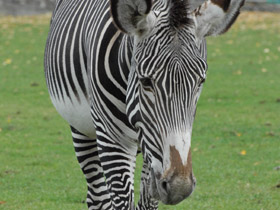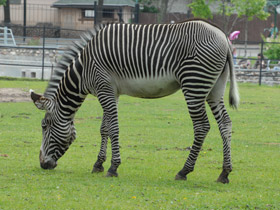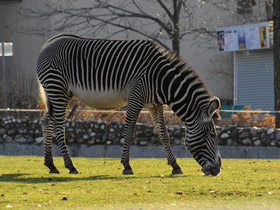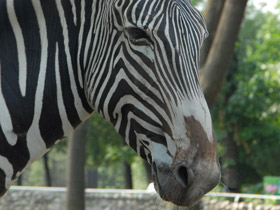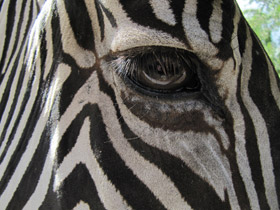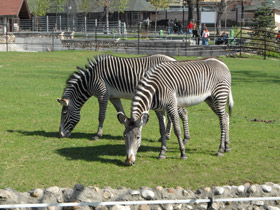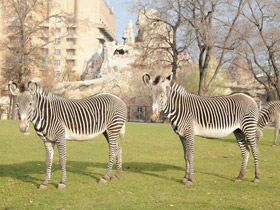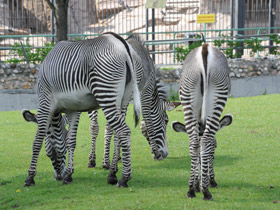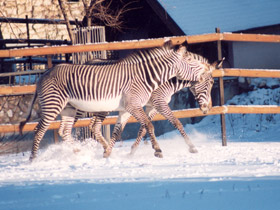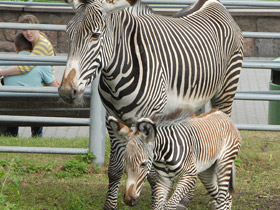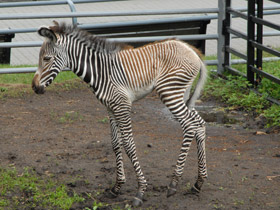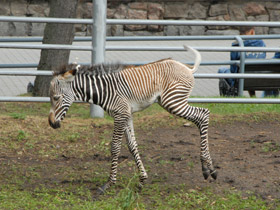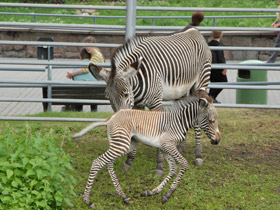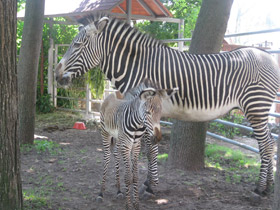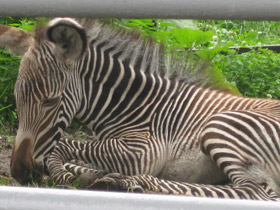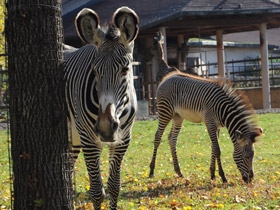Grévy's zebra or the imperial zebra (Equus grevyi)
Grévy's zebra (Equus grevyi), also known as the imperial zebra, is the largest living wild equid and the most threatened of the three species of zebra, the other two being the plains zebra and the mountain zebra. Named after Jules Grévy, it is found in parts of Kenya and Ethiopia. Superficially, Grévy's zebras' physical features can help to identify it from the other zebra species; their overall appearance is slightly closer to that of a mule, compared to the more "equine" (horse) appearance of the plains and mountain zebras. Compared to other zebra species, Grévy's are the tallest; they have mule-like, larger ears, and have the tightest stripes of all zebras. They have distinctively erect manes, and more slender snouts.
The Grévy's zebra live in semi-arid savanna, where they feed on grasses, legumes, and browse, such as acacia; they can survive up to five days without water. They differ from the other zebra species in that they do not live in a harem, and they maintain few long-lasting social bonds. Stallion territoriality and mother–foal relationships form the basis of the social system of the Grévy's zebra. Despite a handful of zoos and animal parks around the world having had successful captive-breeding programs, in its native home this zebra is listed by the IUCN as endangered.
Taxonomy and naming
The Grévy's zebra was first described by French naturalist Émile Oustalet in 1882. He named it after Jules Grévy, then president of France, who, in the 1880s, was given one by the government of Abyssinia. Traditionally, this species was classified in the subgenus Dolichohippus with plains zebra and mountain zebra in Hippotigris. Groves and Bell (2004) place all three species in the subgenus Hippotigris.
Fossils of zebra-like equids have been found throughout Africa and Asia in the Pliocene and Pleistocene deposits. Notable examples include E. sanmeniensis from China, E. cautleyi from India, E. valeriani from central Asia and E. oldowayensis from East Africa. The latter, in particular is very similar to the Grévy's zebra and may have been its ancestor. The modern Grévy's zebra arose in the Middle Pleistocene. Zebras appear to be a monophyletic lineage and recent (2013) phylogenies have placed Grévy's zebra in a sister taxon with the plains zebra. In areas where Grévy's zebras are sympatric with plains zebras, the two may gather in same herds and fertile hybrids do occur.
Appearance and habitat area
Equus grevyi is a species of perissodactyl mammal of the family Equidae. This species of zebra is the most tameable. Equus grevyi is not only the largest zebra, but, with the exception of domestic horses, it is also the largest member of the equine family, weighing between 350 and 430 kg, with a body length of up to 3 m and a height at the withers of approximately 1.4 m. The horse takes its name from French President Jules Grevy, to whom the Government of Abyssinia gave a specimen in the 1880s.
Equus grevyi is common in the arid savannahs of East Africa. It is also perhaps the most beautiful of all zebras: its stripes are much finer than those of other species, widely spaced, and the pattern on its hindquarters differs from that on its sides and legs, revealing a whole system of fine, diagonal stripes around the base of the tail. Most strikingly, the pattern of each zebra is individual (Photo 1-8).
Nutrition
The diet of Equus grevyi consists mainly of various grasses, including sedges, but they also eat tree bark, leaves, shoots and rhizomes. Feeding exclusively on low-calorie plant foods, they are forced to graze for up to 15 hours a day. During the hot season, zebras prefer to graze before dawn and after dusk, taking advantage of midday to rest; during the rainy season, they tend to forage during the day. Zebras need water at least once a day, and lactating mares even more often. In the dry season, they dig holes up to 50 cm deep and 1 metre in diameter with their strong hooves. The water that seeps through the sand collects in the hole and the animals can drink it. When these "wells" dry up, the mass migration of Equus grevyi (and other large ungulates) begins in search of fresh grassy pastures. Grouped in large herds, the animals move hundreds of kilometres and disperse again to new pastures.
Social behaviour and reproduction
A special behavioural trait of Grevy's zebra is that in the breeding season, the stallions do not have harems. Instead, each stallion becomes extremely territorial and defends a small piece of land, attempting to copulate with any female that crosses through his territory.
Equus grevyi are usually kept in groups - herds - with a single adult male as the sire of all foals (photo 9 - zebra rut). When the female gives birth, he is always close by and ready to protect the defenceless spouse from predator attacks. After more than a year of gestation a foal is born which can walk within 20 minutes after birth and is ready to follow its mother (photo 10-15 - foal 2 days old; photo 16 - one week old).
Relationship with humans
The Grévy's zebra was known to the Europeans in antiquity and was used by the Romans in circuses. It was subsequently forgotten in the Western world for a thousand years. In the seventeenth century, the king of Shoa (now central Ethiopia) exported two zebras; one to the Sultan of Turkey and another to the Dutch governor of Jakarta. A century later, in 1882, the government of Abyssinia sent one to French president Jules Grévy. It was at that time that the animal was recognised as its own species and named in Grévy's honour. Grévy's zebra appears on the Eritrean 25-cent coin.

















